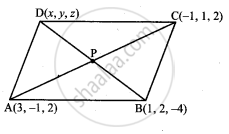Advertisements
Advertisements
Question
Three vertices of a parallelogram ABCD are A (3, –1, 2), B (1, 2, –4) and C (–1, 1, 2). Find the coordinates of the fourth vertex.
Solution
Vertices A and C are (3, –1, 2), (−1, 1, 2) respectively.

Coordinates of the midpoint P between A and C `((3 - 1)/2, (-1 + 1)/2, (2 + 2)/2)` = (1, 0, 2)
Let the coordinates of point D be (x, y, z) and the coordinates of point B be (1, 2, −4).
∴ Mid point of DB `(("x" + 1)/2, ("y" + 2)/2, ("z" - 4)/2)`
The diagonals of a parallelogram divide each other into 2 equal parts.
Therefore, `("x" + 1)/2 = 1, ("y" + 2)/2 = 0, ("z" - 4)/2 = 2`
Hence, the coordinates of point D are (1, –2, 8).
APPEARS IN
RELATED QUESTIONS
The x-axis and y-axis taken together determine a plane known as_______.
Name the octants in which the following points lie:
(7, 4, –3)
Name the octants in which the following points lie:
(–5, –4, 7)
Name the octants in which the following points lie:
(2, –5, –7)
Find the image of:
(–5, 0, 3) in the xz-plane.
Find the image of:
(–4, 0, 0) in the xy-plane.
A cube of side 5 has one vertex at the point (1, 0, –1), and the three edges from this vertex are, respectively, parallel to the negative x and y axes and positive z-axis. Find the coordinates of the other vertices of the cube.
Determine the points in zx-plane are equidistant from the points A(1, –1, 0), B(2, 1, 2) and C(3, 2, –1).
Determine the point on z-axis which is equidistant from the points (1, 5, 7) and (5, 1, –4).
Find the points on z-axis which are at a distance \[\sqrt{21}\]from the point (1, 2, 3).
Prove that the triangle formed by joining the three points whose coordinates are (1, 2, 3), (2, 3, 1) and (3, 1, 2) is an equilateral triangle.
Show that the points A(3, 3, 3), B(0, 6, 3), C(1, 7, 7) and D(4, 4, 7) are the vertices of a square.
Find the coordinates of the point which is equidistant from the four points O(0, 0, 0), A(2, 0, 0), B(0, 3, 0) and C(0, 0, 8).
Are the points A(3, 6, 9), B(10, 20, 30) and C(25, –41, 5), the vertices of a right-angled triangle?
Verify the following:
(0, 7, –10), (1, 6, –6) and (4, 9, –6) are vertices of an isosceles triangle.
Find the locus of the points which are equidistant from the points (1, 2, 3) and (3, 2, –1).
Find the ratio in which the sphere x2 + y2 + z2 = 504 divides the line joining the points (12, –4, 8) and (27, –9, 18).
Find the ratio in which the line segment joining the points (2, 4,5) and (3, −5, 4) is divided by the yz-plane.
XOZ-plane divides the join of (2, 3, 1) and (6, 7, 1) in the ratio
Find the direction cosines of the line passing through the points P(2, 3, 5) and Q(–1, 2, 4).
If a line makes an angle of 30°, 60°, 90° with the positive direction of x, y, z-axes, respectively, then find its direction cosines.
A plane meets the co-ordinates axis in A, B, C such that the centroid of the ∆ABC is the point (α, β, γ). Show that the equation of the plane is `x/alpha + y/beta + z/γ` = 3
The coordinates of the foot of the perpendicular drawn from the point (2, 5, 7) on the x-axis are given by ______.
If a line makes angles `pi/2, 3/4 pi` and `pi/4` with x, y, z axis, respectively, then its direction cosines are ______.
Prove that the lines x = py + q, z = ry + s and x = p′y + q′, z = r′y + s′ are perpendicular if pp′ + rr′ + 1 = 0.
If the line drawn from the point (–2, – 1, – 3) meets a plane at right angle at the point (1, – 3, 3), find the equation of the plane
Find the equations of the two lines through the origin which intersect the line `(x - 3)/2 = (y - 3)/1 = z/1` at angles of `pi/3` each.
Two systems of rectangular axis have the same origin. If a plane cuts them at distances a, b, c and a′, b′, c′, respectively, from the origin, prove that
`1/a^2 + 1/b^2 + 1/c^2 = 1/(a"'"^2) + 1/(b"'"^2) + 1/(c"'"^2)`
Find the foot of perpendicular from the point (2,3,–8) to the line `(4 - x)/2 = y/6 = (1 - z)/3`. Also, find the perpendicular distance from the given point to the line.
Find the length and the foot of perpendicular from the point `(1, 3/2, 2)` to the plane 2x – 2y + 4z + 5 = 0.
Find the equation of the plane which is perpendicular to the plane 5x + 3y + 6z + 8 = 0 and which contains the line of intersection of the planes x + 2y + 3z – 4 = 0 and 2x + y – z + 5 = 0.
The area of the quadrilateral ABCD, where A(0, 4, 1), B(2, 3, –1), C(4, 5, 0) and D(2, 6, 2), is equal to ______.
The plane 2x – 3y + 6z – 11 = 0 makes an angle sin–1(α) with x-axis. The value of α is equal to ______.
The cartesian equation of the plane `vecr * (hati + hatj - hatk)` is ______.
The intercepts made by the plane 2x – 3y + 5z +4 = 0 on the co-ordinate axis are `-2, 4/3, - 4/5`.
The angle between the planes `vecr.(2hati - 3hatj + hatk)` = 1 and `vecr.(hati - hatj)` = 4 is `cos^-1((-5)/sqrt(58))`.
